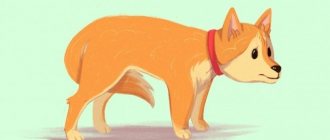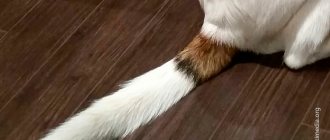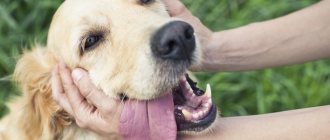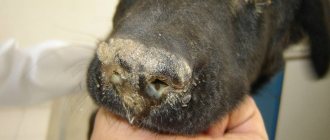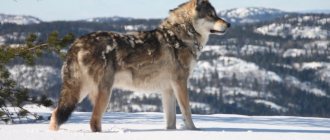Are you used to your dog wagging its tail all the time and suddenly it stops? Is it just hanging there? What does it mean? This article will give you the answer to why a dog's tail hangs!
It's no secret that tails can reveal a lot about a dog's feelings. The type of tail a dog has determines the extent to which it can express its feelings. A wagging tail is usually interpreted as a happy dog. But what does it mean when a dog's tail hangs?
Dogs can express themselves with their tails for many reasons. It is a common belief that dogs only wag their tail when they are happy, but this is actually wrong! Yes, they do indeed wag their tail with joy, but it can also be a sign of aggression or cowardice. Also, if your dog isn't wagging his tail, it doesn't mean he's not happy or friendly. Let's take a closer look!
What does it mean when a dog's tail hangs?
A drooping tail does not necessarily mean your dog is nervous or submissive. If the tail is hanging, it might just mean that he is very relaxed!
But if the tail is tucked between the legs, this is not a sign of a happy dog. This could mean anxiety, but it could also be something less serious - still uncomfortable for your dog! This could mean that your dog is trying to avoid another dog who is trying to sniff him.
© shutterstock
However, a dog's tail should not be down for psychological reasons. If you notice that your tail is suddenly limp, it could be due to a condition called tail limb syndrome.
Physiological reasons
This manifestation is possible in a number of diseases and health problems, we list the main ones:
When a dog is hunched over on top of everything else, this may be a signal of spinal deformation. Most often, such symptoms appear when 2-3 vertebrae rotate. This health problem is detected even in puppyhood and you definitely need to pay attention to it. If the nerves between the vertebrae are pinched, the tail becomes immobile. Quite often, with this defect, there is a hunching of the back, it is difficult for the animal to sit down, and movements are impaired.
In some cases, when a dog shakes and tucks its tail, these are symptoms of hypoglycemia. This condition is caused by a sudden drop in blood sugar levels. For certain breeds of animals, a tucked tail is considered the norm, for example, for a greyhound, and German shepherds with a downward tail are considered purebred and purebred.
When a dog is trembling, lethargic and has its tail between its legs, you should pay attention to the general condition of the animal. Assess appetite, body temperature, whether the dog touches water, and whether it can stand up on its own. Such manifestations can indicate a variety of diseases, these are:
- poisoning;
- toothache;
- diseases of the gastrointestinal tract;
- diseases of the circulatory system.
As you can see, an animal can behave in a similar way with a variety of diseases. What should the owner do in such a situation, how to help his four-legged friend?
Symptoms of the syndrome
The symptoms of tail limb syndrome are quite obvious. The tail will droop and your dog will not wag it as usual. In some cases, the first part of the tail is horizontal while the rest of the tail is vertical.
It may also happen that the tail extends a few centimeters from the body and then drops. Pain and swelling usually accompany a flaccid tail, especially at the base.
The level of pain depends on the dog and can vary greatly, but it is usually a fairly painful condition. To show you pain, your dog may whine or lick and chew its tail. Most dogs are also lethargic when suffering from this condition.
Ulcer
A dog's tail is as vulnerable as other organs of a four-legged friend. One of the most common problems that occurs in dogs is ulcers. Depending on the stage of development of the pathology, there are several forms of tail ulcers:
- initial;
- developing;
- advanced ulcer.
Each form is characterized by certain symptoms and manifestations. So at the initial stage, the owner may notice hair loss and the appearance of a focus of inflammation. The developing form of the ulcer is characterized by expansion of the wound, covering new areas of the skin. In advanced stages, the ulcer affects the root part of the tail, causing necrosis and death of the tail vertebrae.
Causes
There is no single cause of tail ulcers in dogs. Doctors suggest that the main causes of this pathology are:
- mechanical damage to tissue structures;
- internal diseases of organs;
- allergic reactions in an advanced stage;
- violation of the diet.
Symptoms and diagnosis of pathology
The basic sign of an incipient tail ulcer is hair loss in the tail . With further development of the pathology, other characteristic signs appear:
- the appearance of a wound surface;
- rapid spread of focal inflammation;
- the appearance of bleeding from the wound;
- pain in the animal.
To make a correct diagnosis and further prescribe adequate treatment, a consultation with a veterinarian specializing in dermatology is necessary. An accurate diagnosis is made only after passing all the necessary tests and examination by a veterinarian.
Why does a dog's tail hang?
It is still unclear what causes the tail to droop suddenly, but there are certain situations after which it tends to develop. This usually occurs after swimming, hunting, stalking, or other forms of excessive exercise. Thus, overvoltage is the most common cause.
© shutterstock
Other reasons for "why the tail hangs" are climate changes, inappropriate crate sizes or nailing time in the box for too long, sudden cold shock, warm or cold baths, or overuse of the tail.
Although the exact cause is unclear, it is likely a muscle injury. Although the tail appears broken, it is the muscles, not the bones, that are causing the problem. More precisely, your dog is holding his tail down because the damaged coccygeal muscles are at the base. It's like a muscle strain.
Of all the above situations, swimming seems to be the reason for the dog's tail to hang. That's why this condition is also called "swimmer's tail"!
This appears to be explained by the fact that dogs use their tails more often than usual when swimming. Additionally, water dogs tend to swim in fairly cold water, which also contributes to this problem.
Intervertebral hernia
Discopathy or intervertebral hernia is a fairly common phenomenon that occurs in all types of large breeds of dogs. Four-legged friends obtained as a result of many years of selection - Pekingese, Japanese Chins and Dachshunds - are also susceptible to the development of pathology.
Can a dog's tail heal on its own?
Yes . Fortunately, treating tail tail is quite simple if diagnosed correctly. Most dogs recover on their own within a couple of days, but there are certain treatments that can speed up the process. Typically they consist of the following:
- Warm packs at the base of your dog's tail,
- Anti-inflammatory medications specifically for dogs, prescribed by your veterinarian,
- Rest.
Results can be seen fairly quickly. Severe pain usually disappears within 24-48 hours. However, sometimes it can take up to 2 weeks for the problem to completely go away.
If you suspect your dog has tail limb syndrome, try to determine how much the pain is. If the pain doesn't seem too bad, give your dog a rest for a couple of days and wait for the problem to resolve itself. However, if your dog is in severe pain, contact your veterinarian and ask him to prescribe anti-inflammatory medications to relieve the pain.
Necessary actions
The most important thing is to understand the origins of the problem; you should observe the pet’s behavior. It is important to note in what situations the animal behaves this way:
- when you have done something wrong;
- scared;
- feels bad.
When a dog gets scared, it is necessary to change the situation. Create a quiet, pleasant atmosphere and observe how the dog’s behavior changes. It is not recommended to drop everything and calm the dog down, feed him, stroke him and caress him. He may misjudge the owner’s behavior, because if the animal is petted, it means he did something good that the owner liked. In this case, the dog will continue to tuck its tail between its legs at every opportunity and wait for affection and treats.
You just need to distract the dog and relieve nervous tension. You need to act as if nothing happened and ignore the situation. You can do something interesting that will awaken the dog’s curiosity, and he will switch from his own experiences to what is happening. If you understand that this behavior is not associated with fear or other psychological problems, then you should conduct a thorough examination of the animal.
Examination of the animal
Most likely, the animal squeezes this organ between its paws due to the existing discomfort. Perhaps something is bothering him or hurting him. In this case, a timely examination of the dog will help detect the problem and become a reason to contact a veterinarian. What can you do yourself at home?
- Carefully palpate the animal’s belly, check for swelling or lumps.
- Use targeted pressure to check the spine; if the animal becomes more painful, this will certainly manifest itself in whining or sudden movements.
- Inspect the tail and the space under it, it is possible that there is inflammation or damage in this area.
- Look into the animal's mouth, it is quite possible that it is worried about a rotten tooth, examine the gums for inflammation.
- Take your temperature.
If a visual inspection does not produce results, then you can try giving the animal an anesthetic or anti-inflammatory. It is important to constantly monitor the animal, monitor what it eats and drinks, and how it reacts to the owner’s approach. If there is no improvement, you should seek help from a veterinarian. The latter will conduct a qualified examination, take the necessary tests and diagnose the animal.
Based on the above, we can conclude that dogs tuck their tails for a variety of reasons (if they tuck their paws, then that’s different). In order to find out the true cause and somehow help the pet, it is necessary to carefully monitor its behavior and avoid stress. If it is necessary to contact a veterinarian in a timely manner, dogs do not know how to talk and thus convey to us about their condition.
Currently reading:
- Games to choose for training a dog
- Recommendations for obedience of a dog if it growls
- Seven Signs and Remedies for Getting Rid of Fleas in Dogs
- Why does a dog bite and how to stop it from doing so?
The dog often tucks its tail and shakes in the street
The symptom indicates stress, fear or uncertainty. An animal can experience not only recent events, but also disturbing memories from the past. Pets are often frightened by natural events:
- when other dogs try to make friends with them;
- during lightning and thunder;
- if the owner shouts or scolds;
- when another animal attacks.
The first case is due to lack of socialization. The second factor does not depend on breed and upbringing, it is simply a character trait. The third and fourth are the norm - a tail between your legs is a psychosomatic reaction. The owner's job is to protect him from stress.
Small breeds have increased nervousness. If raised incorrectly, they become nervous when they lose personal contact with the owner. Therefore, when training, they are accustomed to the idea that a person leaves him for a while and this is the norm.
Conclusion
The Pomeranian Spitz needs constant care and attention. This is the only way to notice a problem with the tail in time and be able to correct it.
If the reason for a pet’s tail drooping is a genetic predisposition, then in no case should you deprive him of his owner’s love, because he is not to blame for this situation.
Have you read anything important or useful for yourself? Then be sure to share our article with your friends.
Do the Pomeranians in the photo have straight tails?
Another popular misconception among beginning Spitz breeders is that show Pomeranians supposedly have straight tails that lie on their backs. In fact, a straight tail on a Spitz is acceptable, but normally it is a tight “donut”, and groomers can easily create the illusion of a straight tail by combing the tail hair over the back and fixing it with hairspray. Fashions for haircuts and styling change, but the tail of a Pomeranian Spitz should fit tightly to the back, although, of course, a straight tail and a sickle tail are allowed by the breed standard!
Health to you and your pets!
Author Gainulina Elena Leonidovna. Veterinarian at the nursery "from Panda Sharm".
Tail after swimming in Cold WaterDiana O. Gifford, First published in the Labrador Retriever Club, Inc. Yearbook. (1995).
It was the very beginning of the school season and the reservoir seemed to have warmed up enough for training on the water. After working in the water with a hidden feed, the two-year-old black Labrador female was towel dried and placed in a car crate without any visible damage. The next morning, her owner noticed that her tail was not wagging in his usual manner—two-thirds of the tail was hanging limply downward. After examining the back of the dog, it became clear that there was a problem, and when trying to sit the dog down, she even squealed and cried. Fearing that the bitch had broken her tail or suffered some other injury, the owner decided to consult a veterinarian, who had x-rays taken; however, no specific diagnosis was made. Four days later, without any treatment or treatment, the end of the Labrador bitch's tail returned to its normal position.
The expressions “cold water tail”, “bent tail syndrome”, “broken tail”, “dead tail”, “dangling tail” are euphemisms for a phenomenon that is relatively common in sporting dogs. The dog's tail hangs either from the base or starts horizontally three to four inches and then hangs vertically down. A flaccid tail tip usually becomes painful, but it is a relatively minor affliction that can occur after swimming, after a hard day of hunting, or even after a bath in cold water or water that is too warm. This is not always associated with swimming or water, but can also happen after a hard day of work during which the tail was actively working. Most cases of dangling tail syndrome are reported by owners of sporting dog breeds such as Labradors, Golden Retrievers, Setters, Pointers, Flats, Foxhounds and Beagles. Almost all dogs that experience these symptoms return to normal within a few days. Dogs who have had floppy tail syndrome may or may not have the same problem again later in life. (It is the author's experience that symptoms can be repeated in the same animal and can be triggered by something as simple as a cold bath). This ailment is described by laypeople as a “sprain,” fibrosis, or a “cold tail.” At first, a sick dog is unhappy and its tail is painful. If neither the dog owner nor the veterinarian is familiar with this syndrome, it can be very alarming and lead them to suspect a possible spinal cord fracture or disease. Both females and males are susceptible to the problem, as evidenced by the following comment from Ron Mandsager DVM, Nordic Pine Labradors, Stillwater, Oklahoma: “My Labrador male has had this syndrome on two occasions – both lasting a day or two after several days of heavy hunting. (pheasant). In the first case, I was very concerned - the tail was wagging softly and my dog was in obvious discomfort. Not understanding what was going on (this syndrome was never mentioned in Veterinary School) led me to think about a possible fracture or injury to the nerve in the tail. We did a radiographic examination of the pelvic area, but the only thing we could find was enlargement of the ventral (ground-facing) muscles at the base of the tail. It went away spontaneously after a day or two. After the second occurrence of the syndrome and some reflection on what was discovered before its development, I guessed that my dog had a “dangling tail” —
this is a response to more significant tension in the tail muscles than what they are used to. When my Lab hunts pheasants and becomes a bird dog, his tail becomes noticeably active. Between reprises of hard work, my dog is placed in a crate, just like when traveling - this can make the situation worse. This is just a guess, I have no evidence. As a veterinarian, I had never seen or heard of this condition and had no colleagues with whom I discussed this syndrome when I first encountered it.”
Drs. Janet E. Steiss, and Dr. JC Wright, through the Sports Medicine Program at the College of Veterinary Medicine at Auburn University, conducted a study of drooping tail syndrome in hunting dogs. They surveyed sporting dog owners and trainers by mail and telephone as part of a project aimed at identifying the causes of the condition. Their initial inquiries were sent to 418 hunting dog owners and trainers in the Southeastern United States. 90% had owned or trained hunting dogs for more than 10 years, and respondents had a total of 3,066 dogs in their kennels. Seventy-six percent of dogs were used for hunting. Half of them were in the field once a week, and the other half more than once a week. The five breeds that were affected by the syndrome were: English Pointer, English Setter, Foxhound, Beagle and Labrador. As a result of these studies, it appears that floppy tail syndrome is associated with damage to the tail muscles. Dogs that were studied early in the disease showed increased serum creatine phosphokinase (a muscle enzyme). There are similarities between the syndrome in question and "late-onset muscle soreness" in humans. Disturbance in comfortable conditions or overtraining has been the cause in many cases of symptoms of “dangling tail syndrome.” Without identifying the direct cause of the syndrome, veterinarians find it difficult to prescribe specific treatment, but experienced owners and trainers feel that recovery time is reduced if anti-inflammatory drugs are used at the first sign of the syndrome.
